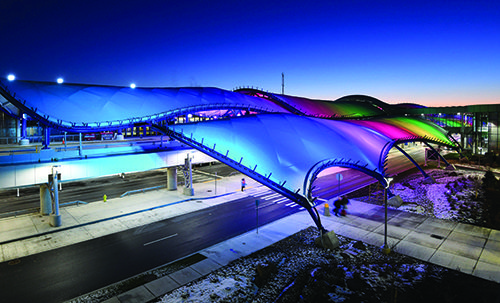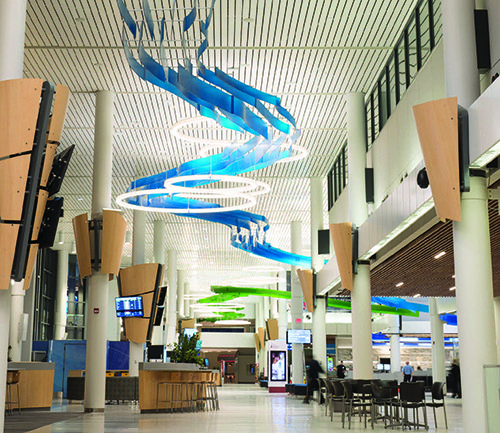It’s not marketing hyperbole when Monroe County Executive Cheryl Dinolfo describes the newly renovated terminal at Greater Rochester International Airport (ROC) as a “next-generation travel hub.” She has plenty of concrete examples to back up the claim. The airport, which serves as a gateway to New York’s Finger Lakes Region, is taking passenger services and building automation to the next level with features such as facility systems that link lights and temperature controls to flight activity; cutting-edge technologies that assist travelers with hearing loss; and real-time video of holdrooms to decrease “gate hugging.”
It’s not marketing hyperbole when Monroe County Executive Cheryl Dinolfo describes the newly renovated terminal at Greater Rochester International Airport (ROC) as a “next-generation travel hub.” She has plenty of concrete examples to back up the claim.
 The airport, which serves as a gateway to New York’s Finger Lakes Region, is taking passenger services and building automation to the next level with features such as facility systems that link lights and temperature controls to flight activity; cutting-edge technologies that assist travelers with hearing loss; and real-time video of holdrooms to decrease “gate hugging.”
The airport, which serves as a gateway to New York’s Finger Lakes Region, is taking passenger services and building automation to the next level with features such as facility systems that link lights and temperature controls to flight activity; cutting-edge technologies that assist travelers with hearing loss; and real-time video of holdrooms to decrease “gate hugging.”
Because ROC was a 2016 winner of Governor Andrew Cuomo’s Upstate Airport Economic and Revitalization Competition, nearly half of the $79 million project was paid for by the state. The rest came from passenger facility charges, the airport authority and the Airport Improvement Program (see Facts & Figures to the right for specific amounts).
|
facts&figures Project: Terminal Rehabilitation Location: Greater Rochester (NY) Int’l Airport Facility Size: 392,708 sq. ft.; 2 concourses Cost: $79 million Funding: Winnings from 2016 Upstate Airport Economic & Revitalization Competition ($39.8 million); passenger facility charges ($31.7 million); airport authority funds ($6.8 million); FAA Airport Improvement Program ($700,000) Timeline: Sept. 2016-Oct. 2018 Interior Design, Architectural & Engineering Consultants: CHA Companies; SEI Design Group Canopy Design & Engineering: Passero Associates Smart Terminal Initiatives: VS Energy Construction Management: LeChase Construction Services Prime Contractors: Alpine Systems (ROCview); Fabritec Structures (canopy); Ramsey Construction (foundation & site work for canopy); Grayco (interior carpentry & ceiling ribbons); Steve General Contractors, Inc. (general contractor) Hearing Assistive Systems: Hewitt Young Electric; Kaplan-Schmidt Electric; Landry Mechanical Contractors; Motion Savvy Significant Features: Real-time gate video that allows travelers to monitor boarding status from outside holdroom; automated facility system that links lights & HVAC controls to flight activity; hearing loops & sign-to-voice translation for travelers with hearing loss; interactive play areas inspired by National Museum of Play; outdoor terminal entrance canopy with colored LED lights Of Note: Project team engaged Rochester Institute of Technology & National Technical Institute for the Deaf in the development of features for customers with hearing loss Awards & Honors: 2018 Most Innovative Small/Medium Hub Airport in the Nation (American Assn. of Airport Executives); 2018 Advocacy Award (Hearing Loss Assn. of America); 2018 Structural Project of the Year Award (American Public Works Assn., Genesee Valley Chapter, NY); 2018 Project of the Year Award – Structures for the Gateway to Monroe County (American Public Works Assn, New York Chapter); 2019 Platinum Award—Transportation (American Council of Engineering Cos, NY); 2019 Community Organization of the Year Award (Hearing Loss Assn. of America); only small-hub U.S. airport selected to present at 2019 Passenger Terminal Expo, London. |
The overarching goal of the renovation was to create a positive environment for travelers and to stimulate local economic development. “From curb to cabin, we wanted to make the travel experience better for everyone in our community,” explains Airport Director Andy Moore.
Currently, ROC serves approximately 2.5 million travelers annually and has an economic impact of more than $800 million per year. Two particularly important local entities include the Rochester Institute of Technology and the National Technical Institute for the Deaf, the world’s largest college for the deaf and hard of hearing.
“Both institutes are significant customers of the airport,” Moore says. “We talked to a lot of people—travel agents, corporate travel managers, business people who use the airport, leisure travelers—and asked a lot of questions to find out how travelers perceive and experience the airport from the minute they come on the property to the minute they leave. That approach all started at the top with Cheryl Dinolfo, who mandated that the airport be integrated with the community.”
First Impressions Count
The airport and county responded to local input with dramatic and inclusive initiatives. From the outside entryway to technological innovations throughout the interior, ROC transformed its 30-year-old terminal into a 21st century high-tech facility custom designed for the unique community it serves.
Where to start? At the entrance to the airport property, of course—where the old New York Department of Transportation road sign, which simply said “Airport” with an arrow, was replaced with a larger, lighted monument sign. In addition, ROC installed energy-efficient LED street light fixtures and updated wayfinding signage for rental car return, departures, arrivals and parking.
A new smartphone lot, with free Wi-Fi and a large flight information display (also LED), helps ease curbside congestion at the terminal. The lot also includes electric vehicle charging stations.
A new canopy that covers the terminal’s departure and arrival roadways is a significant improvement. “An obstacle to travelers was the walk from the parking garage and other parking lots to the terminal through the rain, snow and slush we get here in the Northeast,” Moore explains. Problem solved: Today, travelers move beneath a dramatic canopy built with 1,050 tons of U.S-made steel covered in 87,000 square feet of PTFE Teflon® tensile membrane fabric. The extremely durable and weather-resistant polytetrafluoroethylene woven fiberglass membrane is designed for conditions ranging from frigid artic cold to desert heat and has a life expectancy exceeding 30 years.
In addition to shielding customers from inclement weather, the canopy also provides a stable environment for additional security cameras with facial recognition technology. The project also includes solar panels and a system that collects rainwater for landscape irrigation.
To make the canopy aesthetically pleasing as well as functional, Passero Associates designed it with programmable LED lights (2,200 white and 367 color blast fixtures). The ability to create custom lighting for holidays such as Christmas, Fourth of July or Halloween really gives it the “wow factor,” notes Moore.

The project team had to engineer and build the multipurpose canopy quickly. “Time was short, and the design and construction of this massive structure had to be completed in half the time typical for such a project,” recalls Passero Northeast Aviation Services Director Greg Topping. “This demonstrates what is possible with outstanding teamwork.”
One of a Kind
Partnership and coordination were critical to the renovation’s success, Moore notes. At its peak, the project had approximately 200 construction workers on site at one time. Nevertheless, ROC Deputy Director Bill Johnston reflects, “We were able to overcome the challenges of construction and maintain a fully operational airport with minimal disruption to travelers and tenants throughout the project.”
 CHA Companies served as the lead design and engineering consultant for interior terminal renovations. Per the county’s direction, the design team of CHA Companies and SEI Design Group focused on blending practical and aesthetic improvements. A glass wall etched with the Rochester skyline separates the terminal’s airside and landside areas at the security checkpoint. Acrylic resin ribbons hanging from the ceiling suggest the flow of water prevalent throughout the Finger Lakes region, while also color-coding the two concourses—green for Concourse A and blue for Concourse B.
CHA Companies served as the lead design and engineering consultant for interior terminal renovations. Per the county’s direction, the design team of CHA Companies and SEI Design Group focused on blending practical and aesthetic improvements. A glass wall etched with the Rochester skyline separates the terminal’s airside and landside areas at the security checkpoint. Acrylic resin ribbons hanging from the ceiling suggest the flow of water prevalent throughout the Finger Lakes region, while also color-coding the two concourses—green for Concourse A and blue for Concourse B.
A new web-based control system for facility lighting and heating/venting/air conditioning makes for better energy management and cost efficiency. Integrated with the airport’s flight information display system, the automated control system decreases airflow and dims holdroom lights after aircraft leave. Airport Operations reports that the associated energy savings are significant—about 30% for the entire building.
To assist deaf and hard-of-hearing travelers, digital LED screens throughout the terminal provide wayfinding assistance and visual messaging in coordination with the airport’s paging system. Smart LED color lighting is paired with the flight information display system to communicate active/inactive gates, overhead paging, boarding and emergency information.

At ticketing, rental car and food/beverage counters, cutting-edge sign-to-voice technology is being tested and will be soon deployed to translate American Sign Language hand movements to voice or text for service agents. In addition, the airport installed hearing loops throughout the terminal. The loop system uses a specially designed amplifier connected to the terminal’s public address system and to wiring embedded in the floor. Electrical currents sent through the wires generate electromagnetic fields that can be received by t-coil features in hearing aids or cochlear implants. Customers with such implants or hearing aids can receive amplified audio announcements without ambient background noise. Loops installed at point-of-sale locations such as ticketing, concessions and car rental counters capture and amplify the sound of customer service agents’ voices and deliver it wirelessly to customers wearing hearing aids with t-coils. ROC and the Rochester Chapter of the Hearing Loss Association of America have forged a mutually beneficial relationship over the years; input from the association was invaluable throughout the development, installation and testing of the new system, Moore informs.
 “Much of what we implemented here, the innovative technologies, are the first of their kind in airports,” notes CHA Program Manager Fabio Bendana. “It was groundbreaking. We created a lab right here in the airport where we could test systems and technologies we planned to install. It took quite a few smart people in one room to design these new and unconventional systems.”
“Much of what we implemented here, the innovative technologies, are the first of their kind in airports,” notes CHA Program Manager Fabio Bendana. “It was groundbreaking. We created a lab right here in the airport where we could test systems and technologies we planned to install. It took quite a few smart people in one room to design these new and unconventional systems.”
Security & Service Improvements
While ROC implemented some changes specifically for customers with hearing loss, many are broader based. Catering to tech-toting travelers, the airport installed more than 1,000 new device-charging outlets throughout the terminal and increased the bandwidth of its free Wi-Fi from 3 GB to 500 GB. Other new amenities include a post-security business center and a pre-security conference room for passengers and local businesses alike.
The airport also increased the size of its six-lane TSA checkpoint by 40% to allow more space for queuing and maneuvering carry-on luggage, wheelchairs and strollers. The expansion provides room to better accommodate future passenger traffic growth.
Project design consolidated two concourse exit paths into one centralized exit path to create a new single flow of passengers through the food court and retail concessions area toward a new arrivals greeting area and baggage claim.
Eight facial recognition cameras and 26 object-left-behind cameras with video recording and database subscription crosscheck were installed throughout the interior and exterior areas of the terminal.
A new passenger information network called ROCview allows travelers to view real-time video of gate areas from any location in the terminal, thus eliminating the perceived need to sit within view of their gate. “Our goal is for people to enjoy other areas of the terminal building, whether in a restaurant, business center or play area,” Moore explains. “With this new video technology, they can just pull up their gate on their device and see what’s going on at any point in time. It alleviates stress and anxiety, which is always an important goal in an airport setting.”
To encourage passengers to spend some of their post-security wait time eating and drinking, designers expanded the food court with a shared-use lounge space that features floor-to-ceiling windows overlooking the airfield.

Community Showcase

When ROC’s two-year terminal renovation ended in October 2018, it not only came in on time and on budget, it also garnered a lot of industry awards (see list on Page 39). In many ways, the project provides a blueprint of how to tailor a facility’s structure, services and technologies to the community and travelers it serves: Start by asking questions, then respond specifically and innovatively to the answers received.
“We worked closely with the Rochester Institute of Technology and the National Technical Institute for the Deaf and Hearing Loss Association of America to develop cutting-edge technologies that would make the terminal function more efficiently for the deaf and hard-of-hearing community,” Moore emphasizes. “At the same time, we made a concentrated effort to highlight what the Rochester community at large has to offer.”
For example, Rochester is home to the Strong Museum of Play, one of the largest interactive children’s play museums in the country. To highlight this unique attraction, the airport worked with the museum to develop two indoor interactive play zones for the terminal. The National Toy Hall of Fame-themed area in Concourse A includes a giant toy dump truck, oversized Etch A Sketch and Twister-inspired game for young children. Travelers of all ages can play iconic video games, including a supersized version of Pong, free of charge in Concourse B at the World Video Game Hall of Fame exhibit.

“It’s all part of showing visitors what Rochester has to offer, the hometown feel we wanted to create,” Moore summarizes.
The new terminal exceeds requirements of the 1990 Americans with Disabilities Act (ADA). “With the innovative, one-of-a-kind technologies we’ve put in place for the deaf and hard of hearing, we have expanded services for passengers of all needs,” Bendana reflects. “Each time I am at the airport, someone comments on how intuitive the terminal is with the signage, lighting and colors. This has been a very successful project, and we’re very proud of what the team accomplished for the community.”



